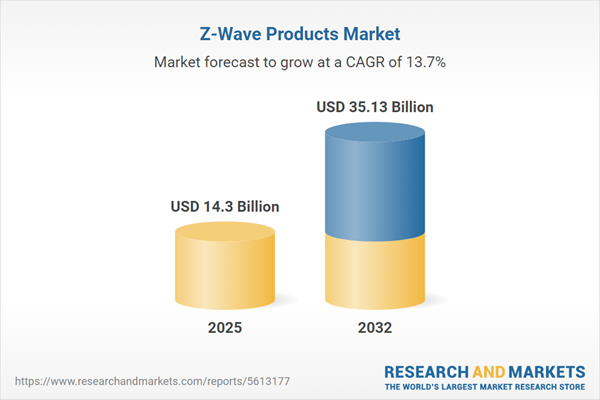Speak directly to the analyst to clarify any post sales queries you may have.
The Z-Wave products market is undergoing substantial change as the demand for integrated, energy-efficient smart home solutions rises among commercial, residential, and industrial users. Senior leaders involved in IoT and automation deployments require actionable intelligence to anticipate trends and navigate the shifting dynamics of Z-Wave-enabled ecosystems.
Market Snapshot: Z-Wave Products Market Growth and Outlook
The Z-Wave products market grew from USD 12.57 billion in 2024 to USD 14.30 billion in 2025. It is projected to advance at a CAGR of 13.70%, reaching USD 35.13 billion by 2032.
Scope & Segmentation: In-Depth Coverage of Z-Wave Solutions
- Product Type: HVAC controllers, thermostats, lighting bulbs, dimmers, single pole switches, three way switches, embedded modules, external modules, door sensors, motion sensors, temperature sensors, smart locks including deadbolts and levers
- Components: Remote controls, system-on-chip (SoC) architectures, transceivers
- Distribution Channel: Online retail, specialty stores
- End User: Commercial facilities, industrial sites, residential dwellings
- Regions Covered:
- Americas: United States, Canada, Mexico, Brazil, Argentina, Chile, Colombia, Peru
- Europe, Middle East & Africa: United Kingdom, Germany, France, Russia, Italy, Spain, Netherlands, Sweden, Poland, Switzerland, United Arab Emirates, Saudi Arabia, Qatar, Turkey, Israel, South Africa, Nigeria, Egypt, Kenya
- Asia-Pacific: China, India, Japan, Australia, South Korea, Indonesia, Thailand, Malaysia, Singapore, Taiwan
- Key Companies Profiled: Silicon Laboratories, Honeywell International, ABB, Leviton Manufacturing, Nortek Control, Fibaro, Aeotec, Everspring Industry, Qubino, Z-Wave Alliance
Technological Landscape
- Wireless Protocol: Z-Wave mesh connectivity supporting energy efficiency and interoperability
- Integration Trends: Modular hardware, AI-driven automation, voice-based interfaces, multi-protocol support (Zigbee, Bluetooth, Wi-Fi)
- Security & Compliance: Enhanced encryption protocols, regulatory-aligned system design, certification for reliability and privacy
Z-Wave Products Market: Key Takeaways for Decision Makers
- Z-Wave stands out as a cornerstone protocol for IoT deployment due to reliable mesh networking and cross-device compatibility.
- Demand increases for user-friendly, secure connected solutions that streamline integration across residential and commercial environments.
- Open collaboration and standardization are shaping ecosystem strategies, leading to greater focus on cross-vendor interoperability and modular design.
- Competitive approaches now emphasize chipset innovation, platform orchestration, and hybrid control systems to serve evolving user needs.
- Diversification of supply chain sourcing and investment in vertical integration respond to recent shifts in global trade and regulatory conditions.
- AI-powered automation and predictive diagnostics drive user value, adding layers of security, convenience, and data-driven service models.
Tariff Impact: Navigating New Cost Structures
Recently implemented United States tariffs on imported smart home components have reshaped procurement for Z-Wave manufacturers and distributors. These changes have led to extended lead times and a transition toward multi-region sourcing to reduce financial exposure. Companies are accelerating investments in modular product designs and enlarging their manufacturing footprints to withstand tariff-related pressures and maintain timely product rollouts. Value engineering and price realignment strategies protect competitive positioning while vertical integration offers greater control over critical chipset and software processes.
Methodology & Data Sources
This study combines primary interviews with industry executives, product architects, and channel partners with robust secondary research from published industry sources, regulatory documents, patent records, and white papers. Triangulated insights and validation panels ensure objective, actionable results for the Z-Wave product market.
Why This Report Matters
- Empowers organizations to anticipate smart home and IoT trends for strategic planning.
- Guides risk mitigation around cost structures, regulation, and supply chain disruptions.
- Provides an actionable foundation for product roadmaps, go-to-market strategies, and investment decisions.
Conclusion
The Z-Wave products market is set for rapid evolution as technology, regulation, and sourcing converge to shape opportunity and risk. Leaders prioritizing interoperability, security, and agile collaboration will be best prepared to capitalize on its future trajectory.
Additional Product Information:
- Purchase of this report includes 1 year online access with quarterly updates.
- This report can be updated on request. Please contact our Customer Experience team using the Ask a Question widget on our website.
Table of Contents
3. Executive Summary
4. Market Overview
7. Cumulative Impact of Artificial Intelligence 2025
Companies Mentioned
The companies profiled in this Z-Wave Products market report include:- Silicon Laboratories, Inc.
- Honeywell International Inc.
- ABB Ltd.
- Leviton Manufacturing Co., Inc.
- Nortek Control, LLC
- Fibaro Sp. z o.o.
- Aeotec Co., Ltd.
- Everspring Industry Co., Ltd.
- Qubino d.o.o.
- Z-Wave Alliance
Table Information
| Report Attribute | Details |
|---|---|
| No. of Pages | 190 |
| Published | October 2025 |
| Forecast Period | 2025 - 2032 |
| Estimated Market Value ( USD | $ 14.3 Billion |
| Forecasted Market Value ( USD | $ 35.13 Billion |
| Compound Annual Growth Rate | 13.7% |
| Regions Covered | Global |
| No. of Companies Mentioned | 11 |









